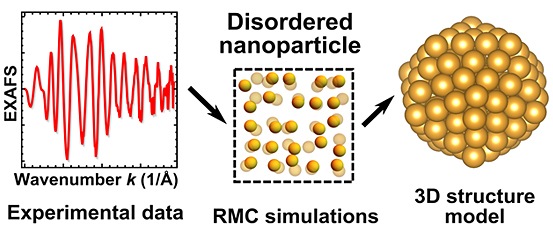- Home
-
Research Groups
Division Groups
- Artificial Photosynthesis
- Catalysis: Reactivity & Structure
- Electrochemical Energy Storage
- Electron- and Photo-Induced Processes for Molecular Energy Conversion
- Neutrino and Nuclear Chemistry
- Surface Electrochemistry and Electrocatalysis
Associated Groups
- Catalysis for Alternative Fuels Production
- Nanostructured Interfaces for Catalysis
- Structure and Dynamics of Applied Nanomaterials
- People
- Operations
- News
- Events

Structure and Dynamics of Applied Nanomaterials
Probing structural relaxation in nanosized catalysts by combining EXAFS and reverse Monte Carlo methods
 Strain-induced structure relaxation, large structural disorder and complex non-Gaussian shape of
the interatomic distances distribution are characteristic even for the simplest monometallic nanocatalysts,
and may have significant impact on many properties, including catalytic ones. Extended X-ray absorption fine
structure (EXAFS) spectroscopy is able to provide unique information on the structure of nanosized catalysts
due to its sensitivity to short-range order in the material. The EXAFS studies of disorder effects in small
nanoparticles (with size 1 - 2 nm) are, however, challenging due to the assumption of quasi-Gaussian bond
length distributions that is made in the conventional analysis.
Strain-induced structure relaxation, large structural disorder and complex non-Gaussian shape of
the interatomic distances distribution are characteristic even for the simplest monometallic nanocatalysts,
and may have significant impact on many properties, including catalytic ones. Extended X-ray absorption fine
structure (EXAFS) spectroscopy is able to provide unique information on the structure of nanosized catalysts
due to its sensitivity to short-range order in the material. The EXAFS studies of disorder effects in small
nanoparticles (with size 1 - 2 nm) are, however, challenging due to the assumption of quasi-Gaussian bond
length distributions that is made in the conventional analysis.
One possible solution shown in this study for bare gold nanoparticles is a novel advanced approach: EXAFS data modelling using reverse Monte Carlo and evolutionary algorithm methods. In addition, we use here classical molecular dynamics simulations to validate the obtained results.
J. Timoshenko and A. I. Frenkel. "Probing structural relaxation in nanosized catalysts by combining EXAFS and reverse Monte Carlo methods." Catalysis Today (2016), http://dx.doi.org/10.1016/j.cattod.2016.05.049




